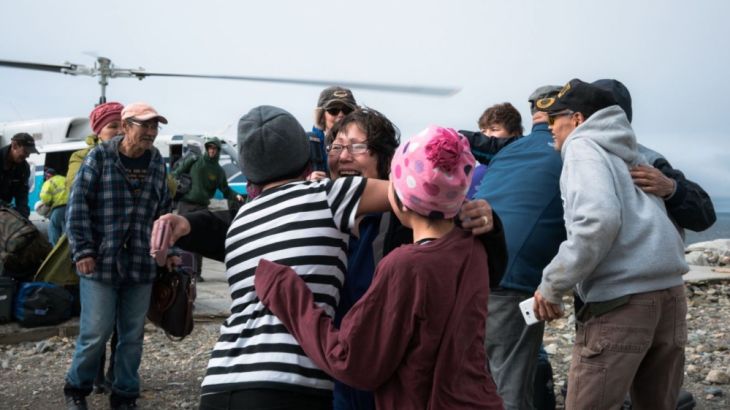
A Cold War Family Reunion
Long after the Cold War and decades of separation, a Native American tribe plans a reunion.
“To survive here, it’s about family.”
-Frances Sistook Ozenna, tribal coordinator, Little Diomede
Close to the Arctic Circle, lie two remote islands. They are only about four kilometres apart, but they are separated by an invisible border known as the “Ice Curtain“.
Keep reading
list of 4 itemsIndigenous people in Philippines’s north ‘ready to fight’ as tensions rise
Curfew announced for under-18s in Australia’s Alice Springs after unrest
‘We exist’: A Himayalan hamlet, forgotten by Indian democracy
Little Diomede is part of the United States. Big Diomede is part of Russia. During the Cold War, the Inupiat tribe living on both islands was torn apart.
I think about how my grandparents must have felt when they separated them. That must have been a big grief for them to lose that connection.
In 1948, the Soviets moved the residents of Big Diomede to mainland Russia. Their relatives on Little Diomede remained.
Now, more than two decades since their last reunion, Frances Sistook Ozenna, a tribal coordinator on Little Diomede, is attempting to reunite her people with their Russian relatives.
“I’ve heard stories a long time ago about how there was interaction between the villages before the Ice Curtain,” she says. “I think about how my grandparents must have felt when they separated them. That must have been a big grief for them to lose that connection.”
But bringing their Russian relatives to Little Diomede is as challenging as thawing volatile US-Russia relations. They must secure visas for the US, and also navigate treacherous storms in order to reach the remote island.
But, conscious that it may be the last opportunity for the tribe’s few remaining elders, Frances and the community are determined to make the reunion happen.
![The Diomede islands are only about four kilometres apart and were traditionally close-knit, but 70 years ago, the Cold War tore the communities part [Al Jazeera]](/wp-content/uploads/2018/06/8e976b196f3446b6954e6563a167e5e8_18.jpeg)
FILMMAKERS’ VIEW
By Jonathan Schienberg and Tik Root
Squint at a map, and you will find two dots in the middle of the Bering Strait, just south of the Arctic Circle, where humans are thought to have first crossed to North America. That’s how we first found the Diomede islands – as cartographic specs. We wondered what was there.
It turns out that the larger of the two dots is Big Diomede, and the smaller is Little Diomede. The sister islands sit only about four kilometres apart and were traditionally close-knit, but, 70 years ago, the Cold War tore the communities part.
To survive here, it's about family.
Today, Big Diomede is a Russian military outpost. Little Diomede is American, and home to a community of about 100 mostly Alaskan Natives.
Largely cut off from the rest of the world, they survive primarily off traditional subsistence sources, such as hunting walrus and polar bear (nearly every part of the animal is used for something), or fermenting food in seal oil.
Still, modernity has a strong – and strengthening – foothold on the island.
In recent years, Little Diomede has gotten high-speed internet access – albeit for only a few hours a day.
And, like everywhere else, many kids are glued to their smartphones and play video games. Even Diomede cannot escape the long reach of Amazon – although delivery times are helicopter and weather-dependent, so never “same-day”.
Figuring out how to capture this mix of tradition, progress and indomitable landscape was challenging in many ways, as was just making initial contact with residents of the island. After several months of reporting and trying to reach someone, we finally connected with Frances Ozenna.
A tribal leader, Ozenna is an island matriarch. She cares deeply about the preservation of her culture and the survival of the island, while also acknowledging and, to an extent embracing, the inevitability of change.
We first spoke to Ozenna last spring, as she was spearheading the island’s effort to reunite with Russian relatives from Big Diomede island, who are now living on the Russian mainland. Neither side had seen the other in decades.
For us, this contemporary narrative was a compelling opportunity to tie together the island’s past, present and future.
Last July, Ozenna and the tribe were finally able to get permission for their relatives to return to Little Diomede.
The trip was plagued by paperwork troubles, weather delays and a near cancellation.
As we waited anxiously on the island, the residents took a more relaxed, wait-and-see, approach. Plans there rarely unfold as anticipated, so they were accustomed to tempering their excitement.
When the relatives finally arrived, though, joy was both evident and abundant. Over the course of the short visit, Ozenna went from greeting people she had never met on the helipad to wanting to see her Russian relatives as often as possible.
As she told us on many occasions, “Diomede is about family.”